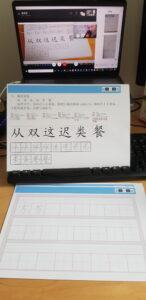UPDATED April 2020: I’ve just spent the last two months working on improving my Chinese handwriting with an online tutor, and I’ve learned so much more in the process! I’ve added to the below section on Learning Materials and Strategies, where I explain how my online tutor worked with me to improve my Chinese characters.
I’ve also added a free printable character worksheet that I designed after having trouble finding one that worked for me. Hope this helps!
Are you ready to learn Chinese characters?
They will challenge you at first – but trust me, the first time you read a Chinese sentence (and it actually makes sense) you will feel such a rush!
Since the Chinese writing system is so drastically different from the alphabet we use for English, you learn to read and write Chinese in a completely different way.
When I first started learning Chinese at university, I learned how to read and write, but as soon as I graduated I shifted my focus to speaking and listening. Now I’m at a point where my speaking ability is much higher than my reading and writing ability and it is getting a bit embarrassing! So this year, my goal is to improve Chinese reading and writing skills.
Here is a summary of what I have learned in the process, along with links to my favorite resources and learning tools!
A Brief History of Chinese Characters
As far as we know, Chinese characters originated in the 1200’s BC (although some historical linguists place that date even earlier). That makes Chinese characters more than 3,000 years old.
Amazingly, Chinese characters used thousands of years ago closely resemble the characters used today. They’ve gone through many iterations and standardizations, but they are recognizable to everyday Chinese readers.
How Characters Work
Characters are made up of components which provide information both on how the character might sound and what it might mean. Some of those components are called radicals, and
However, this information is not systematic – you can’t look at a character and know right away what it means and how to pronounce it. I have more information on this in my earlier blog post, here.
Unfortunately, you’ll just need to memorize each character, what it means, and what it sounds like.
But that’s why not just anybody learns Chinese, right? And I’m sure you’re not just anybody.
Should You Learn Simplified or Traditional Characters?
During the last century, several efforts were made to “simplify” Chinese characters to make them more accessible to everyone. The characters used today were standardized in the 1950’s, and have many fewer strokes than the Traditional characters.
Simplified characters are used in Mainland China and Singapore, whereas Traditional characters are used in Hong Kong and Taiwan.
While of course simplified characters can be learned much faster, many learners believe that traditional characters give you a more meaningful understanding of the language since they contain much more information about meaning and pronunciation. It is totally up to you which system you choose to learn, millions of foreigners learn both every year and become proficient in reading and writing Chinese.
Chinese Stroke Order
One of the most important parts of learning to write Chinese is mastering stroke order.
Yes, it matters. I didn’t think it mattered either, and now I’m stuck with terrible handwriting that it will take me years to undo. The direction and order of your strokes will affect the shape and thickness of your lines and contribute to the overall appearance of your characters. It is definitely worth taking some time to learn the rules.
Here are the rules you will need to know!
The Rules of Mandarin Chinese Stroke Order
I highly recommend you read through these rules a couple times, and see how much you can memorize. But then, just start writing. You can use the workbooks I recommend towards the end of this post (they have helpful lines to keep your writing in check) or just write on anything you can find!
The more you write, the more these rules would become part of your muscle memory.
1. Write from left to right
Most strokes are written from left to right. For example, the character 你 starts with the leftmost vertical strokes before moving on to the strokes on the right.
2. Horizontal before vertical
When strokes cross each other, horizontal strokes are usually written before vertical strokes. For example, for the character 十, the horizontal stroke is written before the vertical stroke.
3. Right-to-left diagonals before left-to-right diagonals
For example, for the character人, the right-to-left diagonal stroke is written before the left-to-right diagonal.
4. From top to bottom.
As an example, the character 二 (two), starts with the top stroke, and ends with the bottom stroke.
5. Outside before inside (for certain cases)
Outside enclosing strokes are written before inside strokes, for example in the character 同.
*This rule applies to the characters with:
Surround from Upper Left structure (for example 危, 友, 发)
Surround from Upper Right structure ( 乌, 可, 包, 乃)
and Surround from Above structure (冈, 闭, 凤, 问)
6. Inside before outside (for other cases)
Sometimes Rule # 5 is reversed, in the case of characters with Surround from Below structure ( 凶)
characters with Surround from Lower Left structure ( 达).
7. Inside before bottom enclosed
When there is a bottom stroke, it is written last. For an example, for the character 因, the outside enclosing strokes are written first, followed by the inside component 大 and then finally the bottom horizontal stroke.
Example: 四
8. Center verticals before outside “wings”
If there is a center vertical stroke flanked by strokes on either side, the center vertical is drawn first. For instance, in the character 小, the center stroke comes before the two strokes to either side.
Example: 水
9. Cutting strokes last
Vertical strokes that “cut” through a character are written after the horizontal strokes they cut through. For example in 千, you start with the horizontal strokes before the vertical.
10. Left vertical before enclosing
Left vertical strokes are written before enclosing strokes.
For example in the character 口,The leftmost vertical stroke (丨) is written first, followed by the uppermost and rightmost lines (┐) (which are written as one stroke).
Example: 日
How to Memorize the Chinese Stroke Order Rules.
I know, there are a lot of rules. How do you make sure you can actually recommend all of that?
First, read the above instructions above carefully so that you understand them. You won’t be able to memorize them right away, this will take some practice.
Then you will need to get the order into your muscle memory through consistent practice.
To do this, either use the practice workbooks I list below, or work with a tutor. I’ll talk more about how I worked with an online tutor to learn Chinese characters below (yes, it is possible to do this virtually!)
Learning Materials and Strategies for Learning Chinese Characters
Once you have familiarized yourself with the basics, I highly recommend writing out characters as much as you can, using notebooks like this one to keep yourself inside the lines. You can also use my free printable worksheet, which leaves space for the character, pinyin, and translation.
It helps to start out writing the characters very big, the way that children do. This is actually harder than writing them small, but will help you see what mistakes you are making and what you need to fix.
Later. you can switch to writing the characters at a normal size, the way adults do. My free printable lets you switch between either size easily.
Practicing characters will be tedious. There is no way around it.
Put on some music to keep yourself focused, or bribe yourself with cookie monster lattes like I do.

I also invested in some erasable gel pens to make the study process more fun and instagrammable.

Trust me, the more you can force/bribe yourself to work on your stroke order, the better off you’ll be in the future. You don’t want to have to unlearn a decade of bad habits, like me!
I’ll introduce some helpful apps below that can do a great job of reinforcing what you learn and helping your long-term memory, but definitely don’t skimp on writing by hand.
How to Work with an Online Tutor to Learn Chinese Characters

Over the last two months, I’ve been working with an online tutor that I found on italki to improve my Chinese handwriting. This is because even though I have studied Chinese for over 10 years, I have terrible penmanship! I internalized a lot of bad habits.
I had always hesitated to work with a tutor on this because I don’t have time to meet a tutor in person, and I didn’t see how I could study writing with a tutor online. How would it work if she couldn’t see my handwriting in real time?
It turns out that with modern technology, it is much easier than it seems!

We met on Skype a few times a week, and she would send me worksheets to print out. Then she wrote on a whiteboard, and I snapped pictures of my handwriting with my phone, uploading it to the Skype chat.
She could easily see my writing samples and give me pointers on how to improve, by using her whiteboard.
If you want to do the same, just reach out to a Chinese tutor on italki and ask them if they are willing to use these methods with you. I am so glad I did it! My handwriting already looks much better.
If I had worked with a tutor from the beginning, I could have spared myself several bad habits. So I definitely recommend you try it out!
Helpful Textbooks and Workbooks
Character Textbook
Tuttle Learning Chinese Characters: (HSK Levels 1-3)
Workbook with Guidance
Integrated Chinese 4th Edition, Volume 1 Character Workbook (Simplified and Traditional Chinese)
Blank Book for Practice
Erasable Color Gel Pens (to make it fun!)
Learning Apps
To supplement (but not replace) your handwriting practice, there are several apps you can use to make the most of dead time throughout your day and make sure that you are reinforcing what you learn.
Very handy app with ready-made “sets” of characters according to topic or HSK level. Click on the character to practice along with the correct stroke order.
Drops has won awards for their alphabet and character packs, which teach Chinese characters, Japanese kanji, Korean hangeul, and more. Follow along with your finger and practice the correct stroke order using their spaced repetition algorithm, and then move on to vocabulary when you are ready.
Dictionary Apps
My favorite dictionary apps are Hanping and Pleco – you can look up Chinese characters using the English word, the Pinyin, or by drawing the character with your finger.
I hope this helps you learn to read and write Chinese. If you have any further suggestions to help other learners, or have any experience with the resources above, please chime in in the comments! 加油 (that means “good luck” in Chinese!)







